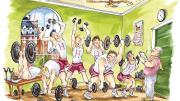1922
Jerome Napoleon Charles Bonaparte, A.B. 1899, declines an invitation to ascend the Albanian throne. “Sometimes Harvard indifference is really carried too far,” comment Bulletin editors.
1927
At a Harvard Club of Boston colloquium titled “What is the Sub-Freshman Thinking About?” the principal of Phillips Exeter Academy reports that many high-school seniors and college freshmen alike answer, “with surprising frankness, ‘Why, Mr. Perry, most of us are not thinking at all.’”
1942
The Faculty of Arts and Sciences approves a compulsory four-hours-a-week program of physical exercise for all undergraduates for the duration, with an emphasis on “physical conditioning and hardening,” not recreation.
1947
A Bulletin “agent” reports that graffiti have been scrawled on Claverly Hall: “Heloise loves Abelard” appears on one corner, “Henry Tudor is insatiable” on another.
On January 7, 300 men gather in a new glass-and-brick building north of Pierce Hall for the official opening of the University’s Computation Laboratory.
1987
“Harvard’s endowment is so large,” report Bulletin editors, “that market swings can have dramatic consequences. In January alone,…the endowment rose 13.75 percent, or $495 million, to reach an all-time high of $4.1 billion.” But University financial managers issue warnings amid the good news: “Expenses for personnel and physical-plant maintenance are rising at a time when federal support for research and for student aid is dropping.”
1997
The magazine’s editors report on the advent of Crimson Cash, which was rolled out in College dining halls the previous fall. It has just been extended to the College Library (replacing the 10 separate copier cards required for its 10 component libraries, recalls then-program administrator Jeff Cuppett), and is about to be extended to laundry and vending machines in all undergraduate dorms and Houses.








